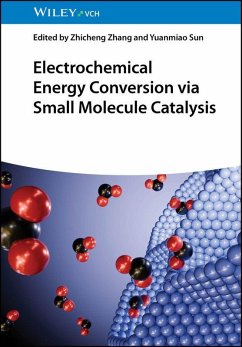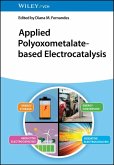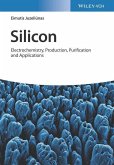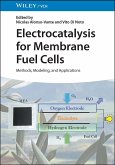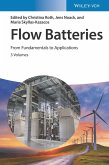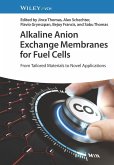Electrochemical Energy Conversion via Small Molecule Catalysis
Herausgegeben:Zhang, Zhicheng; Sun, Yuanmiao
Electrochemical Energy Conversion via Small Molecule Catalysis
Herausgegeben:Zhang, Zhicheng; Sun, Yuanmiao
- Gebundenes Buch
- Merkliste
- Auf die Merkliste
- Bewerten Bewerten
- Teilen
- Produkt teilen
- Produkterinnerung
- Produkterinnerung
Covers the cutting-edge characterization techniques, theoretical calculations for different electrochemical energy conversion reactions.
Andere Kunden interessierten sich auch für
![Applied Polyoxometalate-based Electrocatalysis Applied Polyoxometalate-based Electrocatalysis]() Applied Polyoxometalate-based Electrocatalysis111,99 €
Applied Polyoxometalate-based Electrocatalysis111,99 €![Silicon Silicon]() Eimutis JuzeliunasSilicon97,99 €
Eimutis JuzeliunasSilicon97,99 €![Electrocatalysis for Membrane Fuel Cells Electrocatalysis for Membrane Fuel Cells]() Electrocatalysis for Membrane Fuel Cells126,99 €
Electrocatalysis for Membrane Fuel Cells126,99 €![Flow Batteries, 3 Volume Set Flow Batteries, 3 Volume Set]() Flow Batteries, 3 Volume Set293,99 €
Flow Batteries, 3 Volume Set293,99 €![Rechargeable Organic Batteries Rechargeable Organic Batteries]() Yongzhu FuRechargeable Organic Batteries97,99 €
Yongzhu FuRechargeable Organic Batteries97,99 €![Alkaline Anion Exchange Membranes for Fuel Cells Alkaline Anion Exchange Membranes for Fuel Cells]() Alkaline Anion Exchange Membranes for Fuel Cells112,99 €
Alkaline Anion Exchange Membranes for Fuel Cells112,99 €![Battery Technology Battery Technology]() Alexander BörgerBattery Technology83,99 €
Alexander BörgerBattery Technology83,99 €-
-
-
Covers the cutting-edge characterization techniques, theoretical calculations for different electrochemical energy conversion reactions.
Produktdetails
- Produktdetails
- Verlag: Wiley-VCH
- Artikelnr. des Verlages: 1135440 000
- 1. Auflage
- Seitenzahl: 416
- Erscheinungstermin: 5. November 2025
- Englisch
- Abmessung: 249mm x 175mm x 26mm
- Gewicht: 666g
- ISBN-13: 9783527354405
- ISBN-10: 3527354409
- Artikelnr.: 73650163
- Herstellerkennzeichnung
- Wiley-VCH GmbH
- Boschstraße 12
- 69469 Weinheim
- wiley-vch@kolibri360.de
- Verlag: Wiley-VCH
- Artikelnr. des Verlages: 1135440 000
- 1. Auflage
- Seitenzahl: 416
- Erscheinungstermin: 5. November 2025
- Englisch
- Abmessung: 249mm x 175mm x 26mm
- Gewicht: 666g
- ISBN-13: 9783527354405
- ISBN-10: 3527354409
- Artikelnr.: 73650163
- Herstellerkennzeichnung
- Wiley-VCH GmbH
- Boschstraße 12
- 69469 Weinheim
- wiley-vch@kolibri360.de
Zhicheng Zhang, PhD, is currently a Professor of Tianjin University in China. He is the Associate Editor of SmartMat and an editorial board member of Nano Research, Chinese Chemical Letters, and Rare Metals. Yuanmiao Sun, PhD, is a Professor of Shenzhen Institutes of Advanced Technology, Chinese Academy of Sciences. His research is focused on the design of efficient functional materials via multi-dimensional computation modeling and calculation.
1 INTRODUCTION
1.1 Origins and Evolution of Small Molecule Catalysis for Electrochemical Energy Conversion
1.2 Current State of Small Molecule Catalysis in Electrochemical Energy Conversion
1.3 Challenges in Small Molecule Catalysis for Electrochemical Energy Conversion
1.4 Opportunities and Future Outlook
2 ELECTROCHEMICAL ENERGY CONVERSION TECHNIQUES
2.1. Introduction: The Future is Electrifying
2.2. Fuel Cells and Electrolyzers
2.3. Batteries and Supercapacitors
2.4. Summary
3 CONSTANT-POTENTIAL MODELING IN ELECTROCHEMICAL CO2 REDUCTION
3.1 Introduction
3.2 Principle of Constant-Potential Modeling
3.3 Constant-Potential Modeling of Electrochemical CO2RR
3.3 Conclusion and Outlook
4 ADVANCED IN SITU CHARACTERIZATION TECHNIQUES FOR DIRECT OBSERVATION OF GAS-INVOLVED ELECTROCHEMICAL REACTIONS
4.1 Introduction
4.2 In Situ Infrared Technique
4.3 Electrochemical Quartz Crystal Microbalance
4.4 X-Ray Powder Diffraction
4.5 In Situ Differential Electrochemical Mass Spectrometer
4.6 In Situ Raman Spectroscopy
4.7 In Situ Fluorescence Spectrum
4.8 X-Ray Photoelectron Spectrometer
4.9 Ultroviolet Photoelectron Spectrometer
5 DYNAMIC STRUCTURAL EVOLUTION IDENTIFICATION VIA X-RAY ABSORPTION FINE STRUCTURE
5.1 Introduction
5.2 Fundamentals of XAFS
5.3 XAFS Data Analysis and Interpretation
5.4 In-situ and Operando XAFS Techniques
5.5 Advanced XAFS Methods
5.6 Dynamic Structural Evolution in Catalysts
5.7 Application of XAFS in Electrochemical Energy Conversion
5.8 Conclusions and Outlook
6 ELECTROCHEMICAL HYDROGEN EVOLUTION REACTION
6.1 Introduction
6.2 Performance Evaluation Criteria and Methods
6.3 Advanced Electrocatalysts for HER
6.4 Summary and Perspective
7 ELECTROCHEMICAL OXYGEN EVOLUTION REACTION
7.1 Introduction
7.2 The state-of-the-art characterization techniques
7.3 OER mechanisms
7.4 The mechanism and development status of some typical energy conversion reactions
7.5 Catalysis evaluation and prediction
7.6 Conclusion
8 ELECTROCHEMICAL HYDROGEN/LIQUID FUEL OXIDATION REACTION
8.1 Introduction
8.2 Hydrogen Fuel Oxidation Reaction
8.3 Liquid Fuel Oxidation Reaction
8.4 Conclusion and Outlook
9 CATALYSTS FOR ELECTROCATALYTIC OXYGEN REDUCTION REACTION
9.1 Introduction
9.2 The ORR mechanism
9.3 ORR catalyst characterization techniques
9.4 The category of ORR catalyst
9.5 Pd-based metal catalysts
9.6 Non-platinum group metal catalysts
9.7 Metal-free catalysts
9.8 Single atom catalysts
9.9 Conclusion and Outlook
10 ELECTROCHEMICAL CONVERSION OF BIOMASS DERIVATIVES
10.1 Introduction
10.2 Fundamentals of electrooxidation of biomass derivatives
10.3 Cathodic reaction in biomass electrooxidation system
10.4. Challenges and Future Perspectives
11 ELECTROCHEMICAL CO2 REDUCTION AND CONVERSION
11.1 Introduction
11.2 Fundamentals of Electrochemical CO2 Reduction
11.3 Catalysts for Electrochemical CO2 Reduction
11.4 Mechanisms and Pathways of Electrochemical CO2 Reduction
11.5 Challenges and Opportunities
11.6 Case Studies and Applications
11.7 Future Perspectives
11.8 Conclusion
12 ELECTROCHEMICAL NITROGEN FIXATION AND CONVERSION
12.1 Introduction
12.2 Electrocatalytic N2 reduction reaction (NRR)
12.3. Electrocatalytic N2 oxidation reaction (NOR)
13 RECENT PROGRESS IN ELECTROCHEMICAL C?N COUPLING REACTIONS
13.1 Introduction
13.2 Milestones in Electrocatalytic C-N Coupling
13.3 Fundamentals of Electrocatalytic C-N Coupling
13.4 Electrocatalytic C-N Coupling for Urea Synthesis
13.5 Electrocatalytic C-N Coupling for Amides Synthesis
13.6 Mechanistic Understanding of Electrocatalytic C-N Coupling
13.7 Summary
14 ELECTROCHEMICAL FLUORINATION
14.1 Introducti
1.1 Origins and Evolution of Small Molecule Catalysis for Electrochemical Energy Conversion
1.2 Current State of Small Molecule Catalysis in Electrochemical Energy Conversion
1.3 Challenges in Small Molecule Catalysis for Electrochemical Energy Conversion
1.4 Opportunities and Future Outlook
2 ELECTROCHEMICAL ENERGY CONVERSION TECHNIQUES
2.1. Introduction: The Future is Electrifying
2.2. Fuel Cells and Electrolyzers
2.3. Batteries and Supercapacitors
2.4. Summary
3 CONSTANT-POTENTIAL MODELING IN ELECTROCHEMICAL CO2 REDUCTION
3.1 Introduction
3.2 Principle of Constant-Potential Modeling
3.3 Constant-Potential Modeling of Electrochemical CO2RR
3.3 Conclusion and Outlook
4 ADVANCED IN SITU CHARACTERIZATION TECHNIQUES FOR DIRECT OBSERVATION OF GAS-INVOLVED ELECTROCHEMICAL REACTIONS
4.1 Introduction
4.2 In Situ Infrared Technique
4.3 Electrochemical Quartz Crystal Microbalance
4.4 X-Ray Powder Diffraction
4.5 In Situ Differential Electrochemical Mass Spectrometer
4.6 In Situ Raman Spectroscopy
4.7 In Situ Fluorescence Spectrum
4.8 X-Ray Photoelectron Spectrometer
4.9 Ultroviolet Photoelectron Spectrometer
5 DYNAMIC STRUCTURAL EVOLUTION IDENTIFICATION VIA X-RAY ABSORPTION FINE STRUCTURE
5.1 Introduction
5.2 Fundamentals of XAFS
5.3 XAFS Data Analysis and Interpretation
5.4 In-situ and Operando XAFS Techniques
5.5 Advanced XAFS Methods
5.6 Dynamic Structural Evolution in Catalysts
5.7 Application of XAFS in Electrochemical Energy Conversion
5.8 Conclusions and Outlook
6 ELECTROCHEMICAL HYDROGEN EVOLUTION REACTION
6.1 Introduction
6.2 Performance Evaluation Criteria and Methods
6.3 Advanced Electrocatalysts for HER
6.4 Summary and Perspective
7 ELECTROCHEMICAL OXYGEN EVOLUTION REACTION
7.1 Introduction
7.2 The state-of-the-art characterization techniques
7.3 OER mechanisms
7.4 The mechanism and development status of some typical energy conversion reactions
7.5 Catalysis evaluation and prediction
7.6 Conclusion
8 ELECTROCHEMICAL HYDROGEN/LIQUID FUEL OXIDATION REACTION
8.1 Introduction
8.2 Hydrogen Fuel Oxidation Reaction
8.3 Liquid Fuel Oxidation Reaction
8.4 Conclusion and Outlook
9 CATALYSTS FOR ELECTROCATALYTIC OXYGEN REDUCTION REACTION
9.1 Introduction
9.2 The ORR mechanism
9.3 ORR catalyst characterization techniques
9.4 The category of ORR catalyst
9.5 Pd-based metal catalysts
9.6 Non-platinum group metal catalysts
9.7 Metal-free catalysts
9.8 Single atom catalysts
9.9 Conclusion and Outlook
10 ELECTROCHEMICAL CONVERSION OF BIOMASS DERIVATIVES
10.1 Introduction
10.2 Fundamentals of electrooxidation of biomass derivatives
10.3 Cathodic reaction in biomass electrooxidation system
10.4. Challenges and Future Perspectives
11 ELECTROCHEMICAL CO2 REDUCTION AND CONVERSION
11.1 Introduction
11.2 Fundamentals of Electrochemical CO2 Reduction
11.3 Catalysts for Electrochemical CO2 Reduction
11.4 Mechanisms and Pathways of Electrochemical CO2 Reduction
11.5 Challenges and Opportunities
11.6 Case Studies and Applications
11.7 Future Perspectives
11.8 Conclusion
12 ELECTROCHEMICAL NITROGEN FIXATION AND CONVERSION
12.1 Introduction
12.2 Electrocatalytic N2 reduction reaction (NRR)
12.3. Electrocatalytic N2 oxidation reaction (NOR)
13 RECENT PROGRESS IN ELECTROCHEMICAL C?N COUPLING REACTIONS
13.1 Introduction
13.2 Milestones in Electrocatalytic C-N Coupling
13.3 Fundamentals of Electrocatalytic C-N Coupling
13.4 Electrocatalytic C-N Coupling for Urea Synthesis
13.5 Electrocatalytic C-N Coupling for Amides Synthesis
13.6 Mechanistic Understanding of Electrocatalytic C-N Coupling
13.7 Summary
14 ELECTROCHEMICAL FLUORINATION
14.1 Introducti
1 INTRODUCTION
1.1 Origins and Evolution of Small Molecule Catalysis for Electrochemical Energy Conversion
1.2 Current State of Small Molecule Catalysis in Electrochemical Energy Conversion
1.3 Challenges in Small Molecule Catalysis for Electrochemical Energy Conversion
1.4 Opportunities and Future Outlook
2 ELECTROCHEMICAL ENERGY CONVERSION TECHNIQUES
2.1. Introduction: The Future is Electrifying
2.2. Fuel Cells and Electrolyzers
2.3. Batteries and Supercapacitors
2.4. Summary
3 CONSTANT-POTENTIAL MODELING IN ELECTROCHEMICAL CO2 REDUCTION
3.1 Introduction
3.2 Principle of Constant-Potential Modeling
3.3 Constant-Potential Modeling of Electrochemical CO2RR
3.3 Conclusion and Outlook
4 ADVANCED IN SITU CHARACTERIZATION TECHNIQUES FOR DIRECT OBSERVATION OF GAS-INVOLVED ELECTROCHEMICAL REACTIONS
4.1 Introduction
4.2 In Situ Infrared Technique
4.3 Electrochemical Quartz Crystal Microbalance
4.4 X-Ray Powder Diffraction
4.5 In Situ Differential Electrochemical Mass Spectrometer
4.6 In Situ Raman Spectroscopy
4.7 In Situ Fluorescence Spectrum
4.8 X-Ray Photoelectron Spectrometer
4.9 Ultroviolet Photoelectron Spectrometer
5 DYNAMIC STRUCTURAL EVOLUTION IDENTIFICATION VIA X-RAY ABSORPTION FINE STRUCTURE
5.1 Introduction
5.2 Fundamentals of XAFS
5.3 XAFS Data Analysis and Interpretation
5.4 In-situ and Operando XAFS Techniques
5.5 Advanced XAFS Methods
5.6 Dynamic Structural Evolution in Catalysts
5.7 Application of XAFS in Electrochemical Energy Conversion
5.8 Conclusions and Outlook
6 ELECTROCHEMICAL HYDROGEN EVOLUTION REACTION
6.1 Introduction
6.2 Performance Evaluation Criteria and Methods
6.3 Advanced Electrocatalysts for HER
6.4 Summary and Perspective
7 ELECTROCHEMICAL OXYGEN EVOLUTION REACTION
7.1 Introduction
7.2 The state-of-the-art characterization techniques
7.3 OER mechanisms
7.4 The mechanism and development status of some typical energy conversion reactions
7.5 Catalysis evaluation and prediction
7.6 Conclusion
8 ELECTROCHEMICAL HYDROGEN/LIQUID FUEL OXIDATION REACTION
8.1 Introduction
8.2 Hydrogen Fuel Oxidation Reaction
8.3 Liquid Fuel Oxidation Reaction
8.4 Conclusion and Outlook
9 CATALYSTS FOR ELECTROCATALYTIC OXYGEN REDUCTION REACTION
9.1 Introduction
9.2 The ORR mechanism
9.3 ORR catalyst characterization techniques
9.4 The category of ORR catalyst
9.5 Pd-based metal catalysts
9.6 Non-platinum group metal catalysts
9.7 Metal-free catalysts
9.8 Single atom catalysts
9.9 Conclusion and Outlook
10 ELECTROCHEMICAL CONVERSION OF BIOMASS DERIVATIVES
10.1 Introduction
10.2 Fundamentals of electrooxidation of biomass derivatives
10.3 Cathodic reaction in biomass electrooxidation system
10.4. Challenges and Future Perspectives
11 ELECTROCHEMICAL CO2 REDUCTION AND CONVERSION
11.1 Introduction
11.2 Fundamentals of Electrochemical CO2 Reduction
11.3 Catalysts for Electrochemical CO2 Reduction
11.4 Mechanisms and Pathways of Electrochemical CO2 Reduction
11.5 Challenges and Opportunities
11.6 Case Studies and Applications
11.7 Future Perspectives
11.8 Conclusion
12 ELECTROCHEMICAL NITROGEN FIXATION AND CONVERSION
12.1 Introduction
12.2 Electrocatalytic N2 reduction reaction (NRR)
12.3. Electrocatalytic N2 oxidation reaction (NOR)
13 RECENT PROGRESS IN ELECTROCHEMICAL C?N COUPLING REACTIONS
13.1 Introduction
13.2 Milestones in Electrocatalytic C-N Coupling
13.3 Fundamentals of Electrocatalytic C-N Coupling
13.4 Electrocatalytic C-N Coupling for Urea Synthesis
13.5 Electrocatalytic C-N Coupling for Amides Synthesis
13.6 Mechanistic Understanding of Electrocatalytic C-N Coupling
13.7 Summary
14 ELECTROCHEMICAL FLUORINATION
14.1 Introducti
1.1 Origins and Evolution of Small Molecule Catalysis for Electrochemical Energy Conversion
1.2 Current State of Small Molecule Catalysis in Electrochemical Energy Conversion
1.3 Challenges in Small Molecule Catalysis for Electrochemical Energy Conversion
1.4 Opportunities and Future Outlook
2 ELECTROCHEMICAL ENERGY CONVERSION TECHNIQUES
2.1. Introduction: The Future is Electrifying
2.2. Fuel Cells and Electrolyzers
2.3. Batteries and Supercapacitors
2.4. Summary
3 CONSTANT-POTENTIAL MODELING IN ELECTROCHEMICAL CO2 REDUCTION
3.1 Introduction
3.2 Principle of Constant-Potential Modeling
3.3 Constant-Potential Modeling of Electrochemical CO2RR
3.3 Conclusion and Outlook
4 ADVANCED IN SITU CHARACTERIZATION TECHNIQUES FOR DIRECT OBSERVATION OF GAS-INVOLVED ELECTROCHEMICAL REACTIONS
4.1 Introduction
4.2 In Situ Infrared Technique
4.3 Electrochemical Quartz Crystal Microbalance
4.4 X-Ray Powder Diffraction
4.5 In Situ Differential Electrochemical Mass Spectrometer
4.6 In Situ Raman Spectroscopy
4.7 In Situ Fluorescence Spectrum
4.8 X-Ray Photoelectron Spectrometer
4.9 Ultroviolet Photoelectron Spectrometer
5 DYNAMIC STRUCTURAL EVOLUTION IDENTIFICATION VIA X-RAY ABSORPTION FINE STRUCTURE
5.1 Introduction
5.2 Fundamentals of XAFS
5.3 XAFS Data Analysis and Interpretation
5.4 In-situ and Operando XAFS Techniques
5.5 Advanced XAFS Methods
5.6 Dynamic Structural Evolution in Catalysts
5.7 Application of XAFS in Electrochemical Energy Conversion
5.8 Conclusions and Outlook
6 ELECTROCHEMICAL HYDROGEN EVOLUTION REACTION
6.1 Introduction
6.2 Performance Evaluation Criteria and Methods
6.3 Advanced Electrocatalysts for HER
6.4 Summary and Perspective
7 ELECTROCHEMICAL OXYGEN EVOLUTION REACTION
7.1 Introduction
7.2 The state-of-the-art characterization techniques
7.3 OER mechanisms
7.4 The mechanism and development status of some typical energy conversion reactions
7.5 Catalysis evaluation and prediction
7.6 Conclusion
8 ELECTROCHEMICAL HYDROGEN/LIQUID FUEL OXIDATION REACTION
8.1 Introduction
8.2 Hydrogen Fuel Oxidation Reaction
8.3 Liquid Fuel Oxidation Reaction
8.4 Conclusion and Outlook
9 CATALYSTS FOR ELECTROCATALYTIC OXYGEN REDUCTION REACTION
9.1 Introduction
9.2 The ORR mechanism
9.3 ORR catalyst characterization techniques
9.4 The category of ORR catalyst
9.5 Pd-based metal catalysts
9.6 Non-platinum group metal catalysts
9.7 Metal-free catalysts
9.8 Single atom catalysts
9.9 Conclusion and Outlook
10 ELECTROCHEMICAL CONVERSION OF BIOMASS DERIVATIVES
10.1 Introduction
10.2 Fundamentals of electrooxidation of biomass derivatives
10.3 Cathodic reaction in biomass electrooxidation system
10.4. Challenges and Future Perspectives
11 ELECTROCHEMICAL CO2 REDUCTION AND CONVERSION
11.1 Introduction
11.2 Fundamentals of Electrochemical CO2 Reduction
11.3 Catalysts for Electrochemical CO2 Reduction
11.4 Mechanisms and Pathways of Electrochemical CO2 Reduction
11.5 Challenges and Opportunities
11.6 Case Studies and Applications
11.7 Future Perspectives
11.8 Conclusion
12 ELECTROCHEMICAL NITROGEN FIXATION AND CONVERSION
12.1 Introduction
12.2 Electrocatalytic N2 reduction reaction (NRR)
12.3. Electrocatalytic N2 oxidation reaction (NOR)
13 RECENT PROGRESS IN ELECTROCHEMICAL C?N COUPLING REACTIONS
13.1 Introduction
13.2 Milestones in Electrocatalytic C-N Coupling
13.3 Fundamentals of Electrocatalytic C-N Coupling
13.4 Electrocatalytic C-N Coupling for Urea Synthesis
13.5 Electrocatalytic C-N Coupling for Amides Synthesis
13.6 Mechanistic Understanding of Electrocatalytic C-N Coupling
13.7 Summary
14 ELECTROCHEMICAL FLUORINATION
14.1 Introducti

